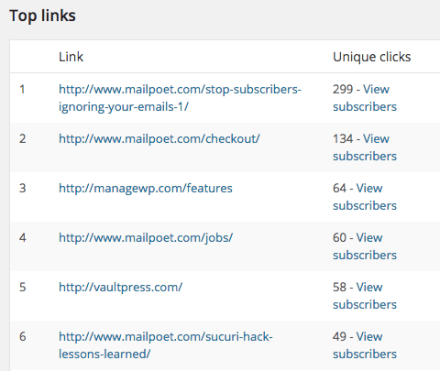Writing links for emails that get clicks
This article explains how to write motivational wording for your links and buttons that will encourage people to click through.
What are you trying to make the subscriber do?
Before you add links to your emails, think carefully about where you are trying to send your subscriber or customer whilst they are reading your emails and what actions you want them to take when they get there. This will help planning your links a lot easier!
Use semantics in sentence links
Avoid using click here for links, it’s not clear enough and doesn’t describe the actual value of the link.
If you’re using a link as part of a sentence, consider rewording the sentence and making the link wording clear and meaningful.
Bad examples:
For more information, click here.
Click here for more information.
Good example:
Find out more information.
Keep it short
Using short, descriptive words to create the link wording will allow the human eye to easily move over it and take in its meaning. Even if you don’t use link underlining, your link should be pulled out in some way (color or font styling) to identify it as a link, which means your eye will be drawn to it.

There’s no fixed amount of letters or characters you should have, but what feels appropriate and, more importantly, makes sense.
In order for the brain to process it quickly and react to it, don’t use long sentences as part of the link. Keep it succinct.
Bad example:
We’d love you tell us what your favourite books are by taking a short survey.
Good example:
We’d love you to tell us your favourite books by taking a short survey.
Link buttons that SELL
If you’re really looking to push your products, use strong, actionable verbs like buy or purchase on a button next to or below your products. We would also recommend using now to accompany the verb as it subconsciously prompts the user to take action immediately rather than coming back to it later, or even forgetting about it altogether.
The above works well if your items are low price and don’t have much complexity or require a lot of decision-making before purchase. However, if your goods have a large ticket price or need a bit more involvement, people may be put off by a Buy now button and being forced through the purchase process too quickly.
For this reason, it is good to test with your own customer base whether having a link where the user can find out more information (even if it links to the same page as the buy now button) or a buy/purchase now link will work better. You might even want to use both, particularly if the focus of the email is just on one or two products.
Good button wording to promote purchase actions
- Buy now
- Buy me
- Shop now
- Order now
- Purchase now
Good button wording to encourage user to get more information
- Find out more
- Learn more
If you wanted to merge the two together, I’ve also seen this used, though I’m not sure it is that effective:
- More info & buy
Success tracking
Of course, you’ll want to be able to see if your revised button wording has had any effect. Once you’ve sent your campaign out, you’ll be able to get statistics about your click rates.
1. You can see a count of how many links were clicked in each newsletter. This also means you can create a new segment per link clicked.

2. You’ll be able to see your most clicked links across all your newsletters in your Statistics page.
3. Go further and track your emails with Google Analytics. Once your readers are on your site, you’ll know which page they go to next. Find out more.
Let us know if you’ve tried these tips and whether they’ve worked for you!